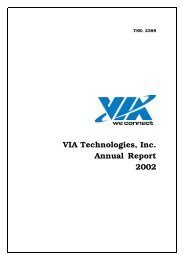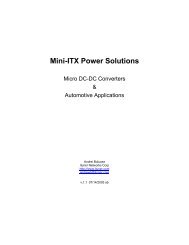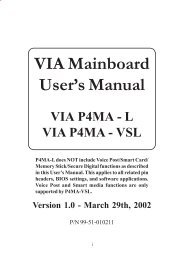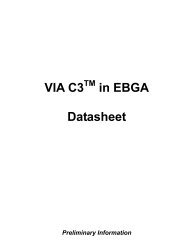via c3 nehemiah random number generator - VIA Technologies, Inc.
via c3 nehemiah random number generator - VIA Technologies, Inc.
via c3 nehemiah random number generator - VIA Technologies, Inc.
Create successful ePaper yourself
Turn your PDF publications into a flip-book with our unique Google optimized e-Paper software.
EVALUATION SUMMARY:<br />
<strong>VIA</strong> C3 NEHEMIAH RANDOM NUMBER GENERATOR<br />
Cryptography Research performed an evaluation of the hardware-based <strong>random</strong> <strong>number</strong><br />
<strong>generator</strong> (RNG) in the <strong>VIA</strong> <strong>Technologies</strong> C3 Nehemiah core. This document summarizes<br />
findings from the technical report prepared for <strong>VIA</strong> <strong>Technologies</strong>.<br />
Background<br />
Randomness is required for a variety of computational,<br />
statistical, and security-related applications. In<br />
particular, cryptographic applications rely on<br />
<strong>random</strong>ness to generate keys, produce unpredictable<br />
challenge values, create padding bytes, and derive other<br />
security-critical parameters. Almost all security<br />
protocols rely on sources of <strong>random</strong>ness, and <strong>random</strong><br />
<strong>number</strong> <strong>generator</strong> flaws are a common security<br />
problem.<br />
Most computers are completely deterministic in<br />
operation, and therefore lack convenient sources of<br />
<strong>random</strong>ness. As a result, developers of security<br />
software rely on software-based pseudo-<strong>random</strong><br />
<strong>number</strong> <strong>generator</strong>s (PRNGs). These <strong>generator</strong>s collect<br />
“seed” data from unpredictable system activity,<br />
including keystrokes, mouse activity, and process<br />
timings. Although PRNG output is not truly <strong>random</strong>,<br />
properly-seeded PRNGs can generate sufficiently<br />
unpredictable output for most<br />
applications. Seeding, however, is<br />
generally a slow process involving<br />
user involvement, creating testing<br />
challenges and difficulties in<br />
automated environments.<br />
The <strong>VIA</strong> <strong>Technologies</strong> C3<br />
Nehemiah core incorporates a<br />
hardware-based <strong>random</strong> <strong>number</strong><br />
<strong>generator</strong> (RNG). This feature can<br />
produce high-entropy output at<br />
fast bit rates. This document<br />
summarizes results from our<br />
testing of the RNG.<br />
C5XL Entropy Source Design<br />
Bias Setting<br />
Bias V<br />
Generator<br />
RNG Design<br />
Ring Oscillators A,B,C<br />
450-810 MHz<br />
Information in this summary is provided without guarantee or warranty of any kind. This review was performed for <strong>VIA</strong><br />
<strong>Technologies</strong>, <strong>Inc</strong>. but represents the findings and opinions of Cryptography Research, <strong>Inc</strong>. and may or may not reflect<br />
opinions of <strong>VIA</strong> <strong>Technologies</strong>, <strong>Inc</strong>. or Centaur Technology. Characteristics of the C3 Nehemiah may vary with design<br />
or implementation changes. Cryptography Research provided no Nehemiah design assistance to <strong>VIA</strong> <strong>Technologies</strong><br />
or Centaur Technology. Copyright © 2003 Cryptography Research, <strong>Inc</strong>. www.cryptography.com<br />
C<br />
B<br />
A<br />
_.<br />
. 8<br />
_.<br />
. 8<br />
XOR<br />
Figure 1: Nehemiah entropy source design.<br />
The RNG contains a raw bit <strong>generator</strong>, digital postprocessing<br />
circuitry, and an interface accessible by a<br />
special-purpose instruction. This section contains a<br />
brief description of the Nehemiah RNG source based on<br />
operational modes recommended by Cryptography<br />
Research.<br />
Raw bit <strong>generator</strong>. A collection of freewheeling<br />
oscillators serves as an entropy source. A slow<br />
freewheeling oscillator (~30 MHz) is utilized to sample<br />
the output of a fast freewheeling oscillator (~600 MHz).<br />
The jitter of the slow oscillator is further increased by<br />
adjusting the oscillator’s bias voltage with output from<br />
two additional fast oscillators. Thermal noise,<br />
manufacturing variations, temperature, software<br />
settings, and local electrical conditions are expected to<br />
contribute entropy to the sampled output.<br />
Digital post-processing . Pairs of bits in the sampled<br />
D<br />
Ring Oscillator D<br />
20-68 MHz<br />
Sampling<br />
Flip Flop<br />
von Neumann<br />
Corrector<br />
Raw Mode<br />
Select<br />
Shift<br />
Register<br />
Byte to<br />
FIFO<br />
1 bit<br />
discard
EVALUATION SUMMARY: <strong>VIA</strong> C3 NEHEMIAH RNG<br />
output are passed through a von Neumann whitener,<br />
which reduces (but does not completely remove) singlebit<br />
biases from the sampled data. 1 Whitened bits are<br />
then accumulated in a FIFO containing four 8-byte<br />
buffers (32 bytes total). To save power, the raw source<br />
oscillators are automatically shut down when the FIFO<br />
is full.<br />
Data requests. User code may retrieve the contents of<br />
one 8-byte buffer at a time <strong>via</strong> the extended x86<br />
XSTORE instruction. Each XSTORE operation either<br />
consumes 8 bytes (one buffer), or returns no data if no<br />
full buffer is available. The XSTORE instruction also<br />
copies the RNG configuration registers to user space,<br />
allowing applications to verify the exact RNG state at<br />
the time of the XTORE call.<br />
Additional modes. The RNG contains advanced<br />
configuration settings that may be used by researchers<br />
and advanced users. 2 Ring 0 (operating system) code<br />
can adjust the oscillator bias voltage, and can optionally<br />
disactivate the von Neumann corrector for testing<br />
purposes. Other modes include a string filter and a 1of-N<br />
bit discarder. The configuration settings are<br />
returned with each data request so that applications can<br />
ensure that the configuration is acceptable.<br />
Summary of Evaluation Results<br />
Testing procedures. Multiple processors were tested in<br />
a range of environmental conditions, oscillator<br />
stop/start usage patterns, and conditions found in multiapplication<br />
environments. The Nehemiah core allows<br />
direct access to the raw (unwhitened) bit <strong>generator</strong><br />
output, permitting the design to be validated with<br />
higher assurance than many other RNG designs.<br />
Because the RNG may be used in multi-application<br />
environments, we included tests that assumed that the<br />
RNG was being shared by hostile processes running<br />
concurrently on the same processor.<br />
Entropy. The raw bit <strong>generator</strong> (whitener disabled) was<br />
estimated to yield 0.78 to 0.99 bits of entropy per raw<br />
output bit. Operation with the whitener enabled is<br />
believed to provide 0.99 bits (typical) of entropy per<br />
1 A von Neumann whitener reduces single-bit biases by<br />
outputting either a single “whitened” bit or no bits for<br />
every 2 bits generated by the raw source. This<br />
whitening process can be disabled for testing purposes.<br />
2 A complete description of operational modes is<br />
available in the <strong>VIA</strong> C5XL Processor Random Number<br />
Generator Application Note, provided by <strong>VIA</strong><br />
<strong>Technologies</strong>.<br />
Figure 2: Serial correlations diminish more quickly<br />
when the von Neumann whitener is enabled<br />
output bit. When used at the recommended settings, it<br />
should be reasonable to assume that the RNG provides<br />
0.75 bits of entropy per output bit. 3 Note that our<br />
recommendations have been chosen conservatively, as<br />
the extremely high performance of the RNG allows<br />
applications to gather extra data with minimal<br />
overhead.<br />
Bitrate. The RNG generates output at significantly<br />
higher rates than most PC-based <strong>random</strong>ness resources.<br />
Raw bits are produced at rates of 30 to 50 Mbits/sec,<br />
and whitened bits were observed at rates of 4 to 9<br />
Mbits/sec. Variations in output rates depend on the<br />
RNG configuration and the oscillator rates. PRNGs<br />
seeded with the Nehemiah RNG should be able to<br />
easily sustain output in excess of 2 Mbits of entropy per<br />
second, which should eliminate blocked PRNG reads in<br />
virtually all applications.<br />
3 Sensitive operations/applications (such as initial<br />
PRNG seeding) should use even more conservative<br />
values if there is no significant performance impact.<br />
MARCH 25, 2003 CRYPTOGRAPHY RESEARCH, INC. PAGE 2 OF 3
EVALUATION SUMMARY: <strong>VIA</strong> C3 NEHEMIAH RNG<br />
31:22 21:16 15 14 13 12:10 9:8 7 6 5 4:0<br />
Reserved String<br />
Filter<br />
Count<br />
Read/<br />
Write<br />
RNG Use<br />
The RNG should be initialized at boot by code with<br />
privileged (ring 0) access to a Nehemiah specific<br />
Machine Specific Register (MSR). The RNG may be<br />
used by any user-level application after it has been<br />
initialized. 4<br />
As with any hardware entropy source, it is<br />
recommended that the Nehemiah RNG be used as a<br />
source of seed data for a cryptographically strong<br />
PRNG or hash function. In such a design, an entropy<br />
pool is periodically seeded with data from XSTORE<br />
calls. The entropy pool may be occasionally “stirred”<br />
with a mixing function, which combines entropy across<br />
Providing PRNG Seed Data<br />
Source<br />
FIFO<br />
and Filters<br />
C5XL RNG<br />
1. SEEDING<br />
XSTORE<br />
String<br />
Filter<br />
Failed<br />
Read/<br />
Write<br />
Entropy Pool<br />
Mixing<br />
Function<br />
2. MIXING<br />
String<br />
Filter<br />
Enable<br />
Read/<br />
Write<br />
3. OUTPUT<br />
Raw bits<br />
enable<br />
Read/ Read/<br />
Write Write<br />
Figure 3: Nehemiah RNG Configuration Register (MSR 0x110B)<br />
Output<br />
Function<br />
Figure 4: Seeding a PRNG with the Nehemiah RNG.<br />
Request<br />
Random<br />
Bytes<br />
RNG outputs. Finally, application requests for <strong>random</strong><br />
<strong>number</strong>s are served by an output function, which<br />
transforms the entropy pool to generate output data for<br />
use by applications.<br />
A well-designed PRNG serves as an entropy buffer in<br />
which the various rates of seeding and output, as well<br />
as the quality of the seed material, determine the quality<br />
of the overall output. In particular, the use of a<br />
cryptographically-based PRNG enables the per-bit<br />
entropy of the Nehemiah RNG to be improved and also<br />
4 <strong>VIA</strong> processor documentation describes procedures<br />
for determining if an RNG-enabled Nehemiah C3 is<br />
present. The complete evaluation report contains<br />
implementation recommendations for configuring and<br />
using output from the RNG.<br />
DC bias Reserved Reserved RNG<br />
enable<br />
provides an additional margin of safety to applications<br />
requiring <strong>random</strong>ness.<br />
Examples of commonly-used PRNGs include the<br />
Linux/UNIX /dev/<strong>random</strong> resource and the Yarrow 5<br />
PRNG. For OS <strong>random</strong>ness resources, the rate of<br />
contributed entropy can be estimated as 0.75 bits of<br />
entropy per XSTORE bit when the RNG is properly<br />
configured, although conservative developers can<br />
always use smaller estimates for this value.<br />
Conclusion<br />
Our analysis indicates that the Nehemiah core Random<br />
Number Generator is a suitable source of entropy for<br />
use in cryptographic applications. Because<br />
the RNG is part of the processor, it can be<br />
easily incorporated into software applications<br />
and functions well within a multi-application<br />
environment without requiring separate<br />
device drivers. Overall, we believe that the<br />
Nehemiah RNG meets the design objective of<br />
providing applications with a highperformance,<br />
high-quality, and easy-to-use<br />
<strong>random</strong> <strong>number</strong> <strong>generator</strong>. We hope that<br />
other vendors will follow <strong>VIA</strong>’s lead and<br />
incorporate <strong>random</strong> sources into their<br />
processor designs.<br />
Application<br />
Reserved Current<br />
Byte<br />
Cout<br />
Read<br />
only<br />
5 Yarrow-160: Notes on the Design and Analysis of the<br />
Yarrow Cryptographic Pseudo<strong>random</strong> Number<br />
Generator, by J. Kelsey, B. Schneier, and N. Ferguson,<br />
1999.<br />
MARCH 25, 2003 CRYPTOGRAPHY RESEARCH, INC. PAGE 3 OF 3<br />
Read/<br />
Write<br />
The complete Cryptography Research<br />
report, “Evaluation of <strong>VIA</strong> C3 Random<br />
Number Generator,” dated February<br />
27, 2003 is available upon request<br />
from <strong>VIA</strong> <strong>Technologies</strong>.








